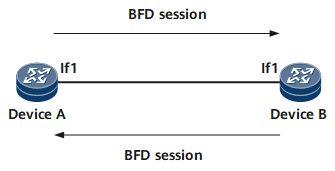BFD for PIS
Bidirectional Forwarding Detection (BFD) for process interface status (PIS) is a simple mechanism in which the behavior of a BFD session is associated with the interface status. BFD for PIS improves the sensitivity of interfaces in detecting link faults and minimizes the impact of faults on non-direct links.
After BFD for PIS is configured and BFD detects a link fault, BFD immediately sends a message indicating the Down state to the associated interface. The interface then enters the BFD Down state, which is equivalent to the Down state of the link protocol. In the BFD Down state, interfaces process only BFD packets to quickly detect link faults.
Configure multicast BFD for each BFD session to be associated with the interface status so that BFD packet forwarding is independent of the IP attributes on the interface.
Usage Scenario
In Figure 1, a BFD session is established between Device A and Device B, and the default multicast address is used to check the continuity of the single-hop link connected to the interface If1. After BFD for PIS is configured and BFD detects a link fault, BFD immediately sends a message indicating the Down state to the associated interface. The interface then enters the BFD Down state.
